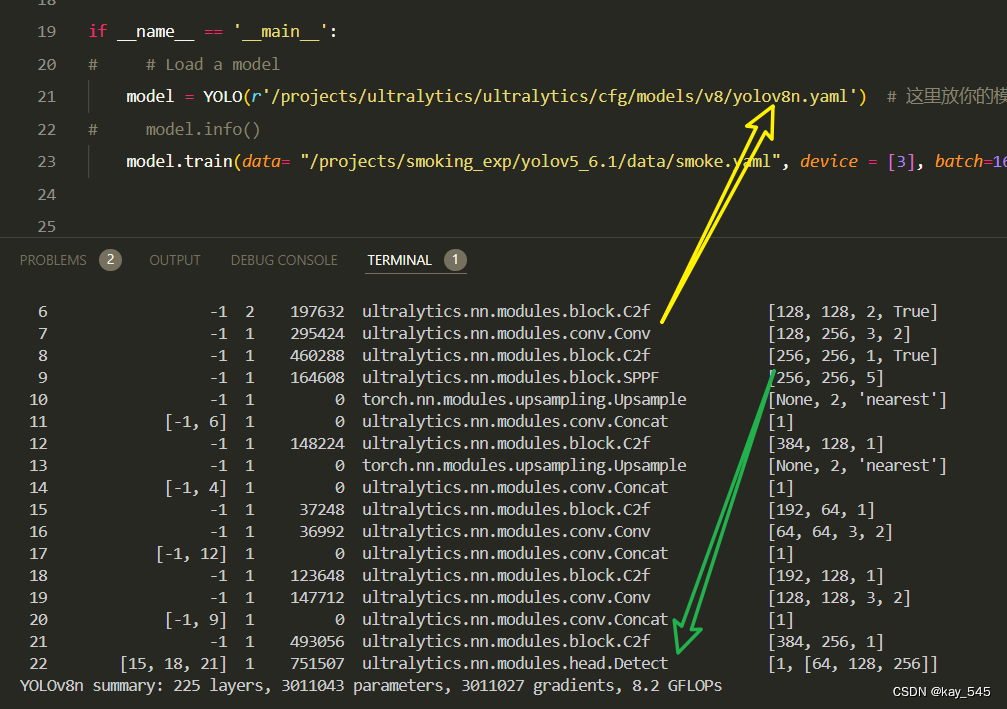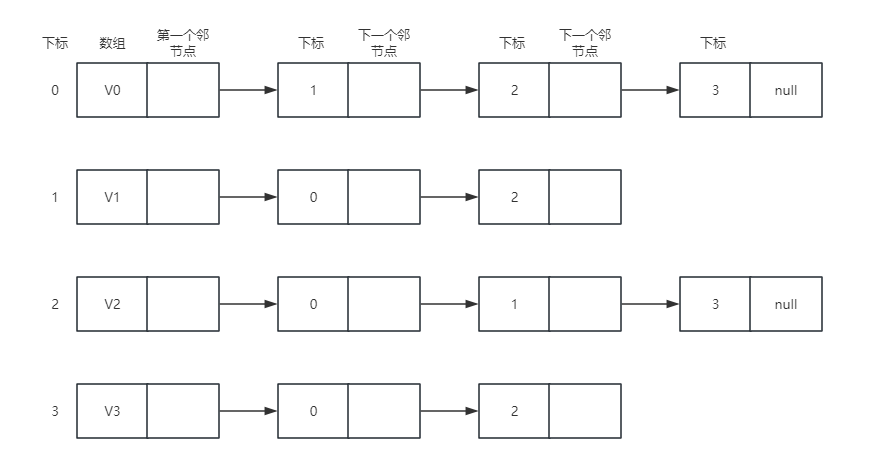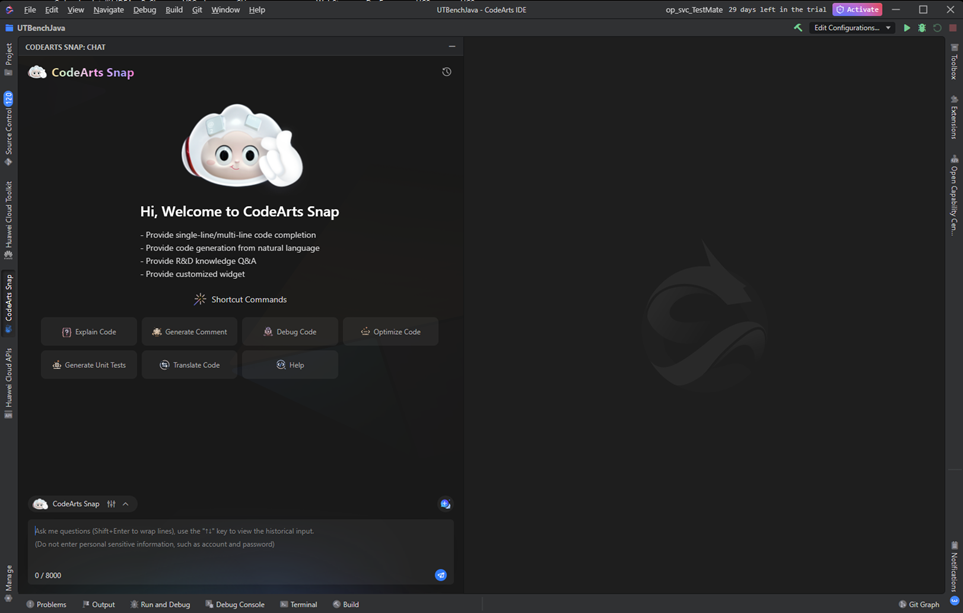秋招面试专栏推荐 :深度学习算法工程师面试问题总结【百面算法工程师】——点击即可跳转
💡💡💡本专栏所有程序均经过测试,可成功执行💡💡💡
专栏目录 :《YOLOv8改进有效涨点》专栏介绍 & 专栏目录 | 目前已有110+篇内容,内含各种Head检测头、损失函数Loss、Backbone、Neck、NMS等创新点改进——点击即可跳转
C2f-RVB 模块是结合了 C2f、RepViT Block 和 EMA 注意力机制的优势,实现了轻量化和高效的模型设计。C2f 模块利用轻量级的 ELAN 注意力机制缓解梯度消失问题,并有效提取关键特征。RepViT Block (RVB) 作为 RepViT 模型的核心组件,通过重新排列 MobileNetV3 模块的 3x3 深度可分离卷积并整合成统一分支。EMA 注意力机制通过对历史数据进行指数移动平均,有效降低噪声或异常值的影响,提高模型的鲁棒性。文章在介绍主要的原理后,将手把手教学如何进行模块的代码添加和修改,并将修改后的完整代码放在文章的最后,方便大家一键运行,小白也可轻松上手实践。以帮助您更好地学习深度学习目标检测YOLO系列的挑战。
专栏地址:YOLOv8改进——更新各种有效涨点方法——点击即可跳转
目录
1.原理
2. 将C2f-RVB添加到yolov8网络中
2.1 C2f-RVB代码实现
2.2 C2f_RVB的神经网络模块代码解析
2.3 更改init.py文件
2.4 添加yaml文件
2.5 注册模块
2.6 执行程序
3. 完整代码分享
4. GFLOPs
5. 进阶
6. 总结
1.原理

论文地址:Efficient Multi-Scale Attention Module with Cross-Spatial Learning——点击即可跳转
官方代码:官方代码仓库——点击即可跳转
C2f-RVB是轻量级网络模块的关键组件,旨在实现高效的特征提取和融合。
核心原理:
-
C2f-RVB结构:YOLOv8网络中的C2f结构,利用轻量级的特征提取来防止梯度消失并有效捕获关键特征。C2f结构包括Conv层和ELAN机制以增强性能。C2f-RVB模块是此结构的扩展,其中集成了RepViT Blocks来替换Bottleneck层。RepViT Blocks通过在推理过程中重新参数化网络架构来提高特征表示和处理效率。
-
RepViT Blocks:是C2f-RVB的核心。RepViT Blocks包括深度卷积和通道间交互机制,可增强特征多样性和表达力,在处理轻量级网络任务时特别有用。这使得模型能够捕捉到更丰富的细节,而不会显著增加计算成本。
-
EMA注意力机制:C2f-RVB中引入了EMA注意力机制来平滑特征权重,减轻检测任务中来自低级特征的噪音。该机制使网络能够更准确地聚焦于重要特征,同时减少背景噪音带来的干扰,提高检测鲁棒性。
总体而言,C2f-RVB模块旨在优化特征提取和融合,专注于提高准确性,同时保持适合在实时应用中部署的轻量级架构。
2. 将C2f-RVB添加到yolov8网络中
2.1 C2f-RVB代码实现
关键步骤一: 将下面代码粘贴到在/ultralytics/ultralytics/nn/modules/block.py中,并在该文件的__all__中添加“C2f-RVB”
from timm.models.layers import SqueezeExcite
class EMA(nn.Module):
def __init__(self, channels, factor=8):
super(EMA, self).__init__()
self.groups = factor
assert channels // self.groups > 0
self.softmax = nn.Softmax(-1)
self.agp = nn.AdaptiveAvgPool2d((1, 1))
self.pool_h = nn.AdaptiveAvgPool2d((None, 1))
self.pool_w = nn.AdaptiveAvgPool2d((1, None))
self.gn = nn.GroupNorm(channels // self.groups, channels // self.groups)
self.conv1x1 = nn.Conv2d(channels // self.groups, channels // self.groups, kernel_size=1, stride=1, padding=0)
self.conv3x3 = nn.Conv2d(channels // self.groups, channels // self.groups, kernel_size=3, stride=1, padding=1)
def forward(self, x):
b, c, h, w = x.size()
group_x = x.reshape(b * self.groups, -1, h, w) # b*g,c//g,h,w
x_h = self.pool_h(group_x)
x_w = self.pool_w(group_x).permute(0, 1, 3, 2)
hw = self.conv1x1(torch.cat([x_h, x_w], dim=2))
x_h, x_w = torch.split(hw, [h, w], dim=2)
x1 = self.gn(group_x * x_h.sigmoid() * x_w.permute(0, 1, 3, 2).sigmoid())
x2 = self.conv3x3(group_x)
x11 = self.softmax(self.agp(x1).reshape(b * self.groups, -1, 1).permute(0, 2, 1))
x12 = x2.reshape(b * self.groups, c // self.groups, -1) # b*g, c//g, hw
x21 = self.softmax(self.agp(x2).reshape(b * self.groups, -1, 1).permute(0, 2, 1))
x22 = x1.reshape(b * self.groups, c // self.groups, -1) # b*g, c//g, hw
weights = (torch.matmul(x11, x12) + torch.matmul(x21, x22)).reshape(b * self.groups, 1, h, w)
return (group_x * weights.sigmoid()).reshape(b, c, h, w)
class Conv2d_BN(torch.nn.Sequential):
def __init__(self, a, b, ks=1, stride=1, pad=0, dilation=1,
groups=1, bn_weight_init=1, resolution=-10000):
super().__init__()
self.add_module('c', torch.nn.Conv2d(
a, b, ks, stride, pad, dilation, groups, bias=False))
self.add_module('bn', torch.nn.BatchNorm2d(b))
torch.nn.init.constant_(self.bn.weight, bn_weight_init)
torch.nn.init.constant_(self.bn.bias, 0)
@torch.no_grad()
def fuse_self(self):
c, bn = self._modules.values()
w = bn.weight / (bn.running_var + bn.eps)**0.5
w = c.weight * w[:, None, None, None]
b = bn.bias - bn.running_mean * bn.weight / \
(bn.running_var + bn.eps)**0.5
m = torch.nn.Conv2d(w.size(1) * self.c.groups, w.size(
0), w.shape[2:], stride=self.c.stride, padding=self.c.padding, dilation=self.c.dilation, groups=self.c.groups,
device=c.weight.device)
m.weight.data.copy_(w)
m.bias.data.copy_(b)
return m
class Residual(nn.Module):
def __init__(self, fn):
super(Residual, self).__init__()
self.fn = fn
def forward(self, x):
return self.fn(x) + x
class SEAM(nn.Module):
def __init__(self, c1, c2, n, reduction=16):
super(SEAM, self).__init__()
if c1 != c2:
c2 = c1
self.DCovN = nn.Sequential(
*[nn.Sequential(
Residual(nn.Sequential(
nn.Conv2d(in_channels=c2, out_channels=c2, kernel_size=3, stride=1, padding=1, groups=c2),
nn.GELU(),
nn.BatchNorm2d(c2)
)),
nn.Conv2d(in_channels=c2, out_channels=c2, kernel_size=1, stride=1, padding=0, groups=1),
nn.GELU(),
nn.BatchNorm2d(c2)
) for i in range(n)]
)
self.avg_pool = torch.nn.AdaptiveAvgPool2d(1)
self.fc = nn.Sequential(
nn.Linear(c2, c2 // reduction, bias=False),
nn.ReLU(inplace=True),
nn.Linear(c2 // reduction, c2, bias=False),
nn.Sigmoid()
)
self._initialize_weights()
# self.initialize_layer(self.avg_pool)
self.initialize_layer(self.fc)
def forward(self, x):
b, c, _, _ = x.size()
y = self.DCovN(x)
y = self.avg_pool(y).view(b, c)
y = self.fc(y).view(b, c, 1, 1)
y = torch.exp(y)
return x * y.expand_as(x)
def _initialize_weights(self):
for m in self.modules():
if isinstance(m, nn.Conv2d):
nn.init.xavier_uniform_(m.weight, gain=1)
elif isinstance(m, nn.BatchNorm2d):
nn.init.constant_(m.weight, 1)
nn.init.constant_(m.bias, 0)
def initialize_layer(self, layer):
if isinstance(layer, (nn.Conv2d, nn.Linear)):
torch.nn.init.normal_(layer.weight, mean=0., std=0.001)
if layer.bias is not None:
torch.nn.init.constant_(layer.bias, 0)
class RepViTBlock(nn.Module):
def __init__(self, inp, oup, use_se=True):
super(RepViTBlock, self).__init__()
self.identity = inp == oup
hidden_dim = 2 * inp
self.token_mixer = nn.Sequential(
RepVGGDW(inp),
SqueezeExcite(inp, 0.25) if use_se else nn.Identity(),
)
self.channel_mixer = Residual(nn.Sequential(
# pw
Conv2d_BN(inp, hidden_dim, 1, 1, 0),
nn.GELU(),
# pw-linear
Conv2d_BN(hidden_dim, oup, 1, 1, 0, bn_weight_init=0),
))
def forward(self, x):
return self.channel_mixer(self.token_mixer(x))
class RepViTBlock_EMA(RepViTBlock):
def __init__(self, inp, oup, use_se=True):
super().__init__(inp, oup, use_se)
self.token_mixer = nn.Sequential(
RepVGGDW(inp),
EMA(inp) if use_se else nn.Identity(),
)
class C3_RVB(C3):
def __init__(self, c1, c2, n=1, shortcut=False, g=1, e=0.5):
super().__init__(c1, c2, n, shortcut, g, e)
c_ = int(c2 * e) # hidden channels
self.m = nn.Sequential(*(RepViTBlock(c_, c_, False) for _ in range(n)))
class C2f_RVB(C2f):
def __init__(self, c1, c2, n=1, shortcut=False, g=1, e=0.5):
super().__init__(c1, c2, n, shortcut, g, e)
self.m = nn.ModuleList(RepViTBlock(self.c, self.c, False) for _ in range(n))
2.2 C2f_RVB的神经网络模块代码解析
C2f_RVB 模块是 C2f 结构的扩展,集成了 RepViTBlocks,通过高效的重新参数化和特征提取来提高性能。
-
C2f 结构:基础
C2f模块融合多尺度特征,同时保持轻量级结构。它由多个具有深度卷积和高效特征融合机制的层组成。原始C2f专注于捕获丰富的特征表示,同时平衡计算成本。 -
RepViT 块集成:
C2f_RVB模块中引入的 RepViTBlock 通过添加重新参数化的卷积进一步增强了C2f的功能。这使模块能够通过在推理过程中更有效地融合特征来适应不同的计算环境。 RepViT 模块还包括深度卷积和可选的挤压和激发 (SE) 模块,以提高空间注意力。 -
通道和标记混合:每个
RepViTBlock都使用 标记混合(深度卷积和 SE/EMA 注意力)和 通道混合(逐点卷积)的组合。标记混合器提取不同的特征表示,而通道混合器增强通道间关系,从而实现更有效的特征融合。 -
通过重新参数化提高效率:
RepViTBlock在推理过程中将多分支结构重新参数化为单分支配置,在保持模型准确性的同时减少计算开销。这使得C2f_RVB模块既轻量又具有计算效率。 -
EMA Attention:
C2f_RVB还可以在 token 混合阶段利用EMA注意力机制,其中 EMA 有助于平滑特征权重并减少浅层噪声,从而增强模型在实时或低功耗环境下的鲁棒性。
C2f_RVB 模块将 C2f 的多尺度特征融合与 RepViTBlocks 的高效特征提取相结合,使其成为需要高精度和计算效率的轻量级模型的理想选择。

2.3 更改init.py文件
关键步骤二:修改modules文件夹下的__init__.py文件,先导入函数

然后在下面的__all__中声明函数

2.4 添加yaml文件
关键步骤三:在/ultralytics/ultralytics/cfg/models/v8下面新建文件yolov8_C2f_RVB.yaml文件,粘贴下面的内容
- OD【目标检测】
# Ultralytics YOLO 🚀, AGPL-3.0 license
# YOLOv8 object detection model with P3-P5 outputs. For Usage examples see https://docs.ultralytics.com/tasks/detect
# Parameters
nc: 80 # number of classes
scales: # model compound scaling constants, i.e. 'model=yolov8n.yaml' will call yolov8.yaml with scale 'n'
# [depth, width, max_channels]
n: [0.33, 0.25, 1024] # YOLOv8n summary: 225 layers, 3157200 parameters, 3157184 gradients, 8.9 GFLOPs
s: [0.33, 0.50, 1024] # YOLOv8s summary: 225 layers, 11166560 parameters, 11166544 gradients, 28.8 GFLOPs
m: [0.67, 0.75, 768] # YOLOv8m summary: 295 layers, 25902640 parameters, 25902624 gradients, 79.3 GFLOPs
l: [1.00, 1.00, 512] # YOLOv8l summary: 365 layers, 43691520 parameters, 43691504 gradients, 165.7 GFLOPs
x: [1.00, 1.25, 512] # YOLOv8x summary: 365 layers, 68229648 parameters, 68229632 gradients, 258.5 GFLOPs
# YOLOv8.0n backbone
backbone:
# [from, repeats, module, args]
- [-1, 1, Conv, [64, 3, 2]] # 0-P1/2
- [-1, 1, Conv, [128, 3, 2]] # 1-P2/4
- [-1, 3, C2f_RVB, [128, True]]
- [-1, 1, Conv, [256, 3, 2]] # 3-P3/8
- [-1, 6, C2f_RVB, [256, True]]
- [-1, 1, Conv, [512, 3, 2]] # 5-P4/16
- [-1, 6, C2f_RVB, [512, True]]
- [-1, 1, Conv, [1024, 3, 2]] # 7-P5/32
- [-1, 3, C2f_RVB, [1024, True]]
- [-1, 1, SPPF, [1024, 5]] # 9
# YOLOv8.0n head
head:
- [-1, 1, nn.Upsample, [None, 2, 'nearest']]
- [[-1, 6], 1, Concat, [1]] # cat backbone P4
- [-1, 3, C2f_RVB, [512]] # 12
- [-1, 1, nn.Upsample, [None, 2, 'nearest']]
- [[-1, 4], 1, Concat, [1]] # cat backbone P3
- [-1, 3, C2f_RVB, [256]] # 15 (P3/8-small)
- [-1, 1, Conv, [256, 3, 2]]
- [[-1, 12], 1, Concat, [1]] # cat head P4
- [-1, 3, C2f_RVB, [512]] # 18 (P4/16-medium)
- [-1, 1, Conv, [512, 3, 2]]
- [[-1, 9], 1, Concat, [1]] # cat head P5
- [-1, 3, C2f_RVB, [1024]] # 21 (P5/32-large)
- [[15, 18, 21], 1, Detect, [nc]] # Detect(P3, P4, P5)
- Seg【语义分割】
# Ultralytics YOLO 🚀, AGPL-3.0 license
# YOLOv8 object detection model with P3-P5 outputs. For Usage examples see https://docs.ultralytics.com/tasks/detect
# Parameters
nc: 80 # number of classes
scales: # model compound scaling constants, i.e. 'model=yolov8n.yaml' will call yolov8.yaml with scale 'n'
# [depth, width, max_channels]
n: [0.33, 0.25, 1024] # YOLOv8n summary: 225 layers, 3157200 parameters, 3157184 gradients, 8.9 GFLOPs
s: [0.33, 0.50, 1024] # YOLOv8s summary: 225 layers, 11166560 parameters, 11166544 gradients, 28.8 GFLOPs
m: [0.67, 0.75, 768] # YOLOv8m summary: 295 layers, 25902640 parameters, 25902624 gradients, 79.3 GFLOPs
l: [1.00, 1.00, 512] # YOLOv8l summary: 365 layers, 43691520 parameters, 43691504 gradients, 165.7 GFLOPs
x: [1.00, 1.25, 512] # YOLOv8x summary: 365 layers, 68229648 parameters, 68229632 gradients, 258.5 GFLOPs
# YOLOv8.0n backbone
backbone:
# [from, repeats, module, args]
- [-1, 1, Conv, [64, 3, 2]] # 0-P1/2
- [-1, 1, Conv, [128, 3, 2]] # 1-P2/4
- [-1, 3, C2f_RVB, [128, True]]
- [-1, 1, Conv, [256, 3, 2]] # 3-P3/8
- [-1, 6, C2f_RVB, [256, True]]
- [-1, 1, Conv, [512, 3, 2]] # 5-P4/16
- [-1, 6, C2f_RVB, [512, True]]
- [-1, 1, Conv, [1024, 3, 2]] # 7-P5/32
- [-1, 3, C2f_RVB, [1024, True]]
- [-1, 1, SPPF, [1024, 5]] # 9
# YOLOv8.0n head
head:
- [-1, 1, nn.Upsample, [None, 2, 'nearest']]
- [[-1, 6], 1, Concat, [1]] # cat backbone P4
- [-1, 3, C2f_RVB, [512]] # 12
- [-1, 1, nn.Upsample, [None, 2, 'nearest']]
- [[-1, 4], 1, Concat, [1]] # cat backbone P3
- [-1, 3, C2f_RVB, [256]] # 15 (P3/8-small)
- [-1, 1, Conv, [256, 3, 2]]
- [[-1, 12], 1, Concat, [1]] # cat head P4
- [-1, 3, C2f_RVB, [512]] # 18 (P4/16-medium)
- [-1, 1, Conv, [512, 3, 2]]
- [[-1, 9], 1, Concat, [1]] # cat head P5
- [-1, 3, C2f_RVB, [1024]] # 21 (P5/32-large)
- [[15, 18, 21], 1, Segment, [nc, 32, 256]] # Segment(P3, P4, P5)
温馨提示:因为本文只是对yolov8基础上添加模块,如果要对yolov8n/l/m/x进行添加则只需要指定对应的depth_multiple 和 width_multiple。不明白的同学可以看这篇文章: yolov8yaml文件解读——点击即可跳转
# YOLOv8n
depth_multiple: 0.33 # model depth multiple
width_multiple: 0.25 # layer channel multiple
max_channels: 1024 # max_channels
# YOLOv8s
depth_multiple: 0.33 # model depth multiple
width_multiple: 0.50 # layer channel multiple
max_channels: 1024 # max_channels
# YOLOv8l
depth_multiple: 1.0 # model depth multiple
width_multiple: 1.0 # layer channel multiple
max_channels: 512 # max_channels
# YOLOv8m
depth_multiple: 0.67 # model depth multiple
width_multiple: 0.75 # layer channel multiple
max_channels: 768 # max_channels
# YOLOv8x
depth_multiple: 1.33 # model depth multiple
width_multiple: 1.25 # layer channel multiple
max_channels: 512 # max_channels2.5 注册模块
关键步骤四:在task.py的parse_model函数中注册

2.6 执行程序
在train.py中,将model的参数路径设置为yolov8_C2f_RVB.yaml的路径
建议大家写绝对路径,确保一定能找到
from ultralytics import YOLO
import warnings
warnings.filterwarnings('ignore')
from pathlib import Path
if __name__ == '__main__':
# 加载模型
model = YOLO("ultralytics/cfg/v8/yolov8.yaml") # 你要选择的模型yaml文件地址
# Use the model
results = model.train(data=r"你的数据集的yaml文件地址",
epochs=100, batch=16, imgsz=640, workers=4, name=Path(model.cfg).stem) # 训练模型🚀运行程序,如果出现下面的内容则说明添加成功🚀
from n params module arguments
0 -1 1 464 ultralytics.nn.modules.conv.Conv [3, 16, 3, 2]
1 -1 1 4672 ultralytics.nn.modules.conv.Conv [16, 32, 3, 2]
2 -1 1 4800 ultralytics.nn.modules.block.C2f_RVB [32, 32, 1, True]
3 -1 1 18560 ultralytics.nn.modules.conv.Conv [32, 64, 3, 2]
4 -1 2 25088 ultralytics.nn.modules.block.C2f_RVB [64, 64, 2, True]
5 -1 1 73984 ultralytics.nn.modules.conv.Conv [64, 128, 3, 2]
6 -1 2 91136 ultralytics.nn.modules.block.C2f_RVB [128, 128, 2, True]
7 -1 1 295424 ultralytics.nn.modules.conv.Conv [128, 256, 3, 2]
8 -1 1 239104 ultralytics.nn.modules.block.C2f_RVB [256, 256, 1, True]
9 -1 1 164608 ultralytics.nn.modules.block.SPPF [256, 256, 5]
10 -1 1 0 torch.nn.modules.upsampling.Upsample [None, 2, 'nearest']
11 [-1, 6] 1 0 ultralytics.nn.modules.conv.Concat [1]
12 -1 1 94976 ultralytics.nn.modules.block.C2f_RVB [384, 128, 1]
13 -1 1 0 torch.nn.modules.upsampling.Upsample [None, 2, 'nearest']
14 [-1, 4] 1 0 ultralytics.nn.modules.conv.Concat [1]
15 -1 1 24960 ultralytics.nn.modules.block.C2f_RVB [192, 64, 1]
16 -1 1 36992 ultralytics.nn.modules.conv.Conv [64, 64, 3, 2]
17 [-1, 12] 1 0 ultralytics.nn.modules.conv.Concat [1]
18 -1 1 70400 ultralytics.nn.modules.block.C2f_RVB [192, 128, 1]
19 -1 1 147712 ultralytics.nn.modules.conv.Conv [128, 128, 3, 2]
20 [-1, 9] 1 0 ultralytics.nn.modules.conv.Concat [1]
21 -1 1 271872 ultralytics.nn.modules.block.C2f_RVB [384, 256, 1]
22 [15, 18, 21] 1 897664 ultralytics.nn.modules.head.Detect [80, [64, 128, 256]]
YOLOv8_C2f_RVB summary: 375 layers, 2462416 parameters, 2462400 gradients, 7.2 GFLOPs3. 完整代码分享
https://pan.baidu.com/s/1BuYHDDaGDlQkmCax--csLA?pwd=shtv提取码: shtv
4. GFLOPs
关于GFLOPs的计算方式可以查看:百面算法工程师 | 卷积基础知识——Convolution
未改进的YOLOv8nGFLOPs

改进后的GFLOPs

5. 进阶
可以与其他的注意力机制或者损失函数等结合,进一步提升检测效果
6. 总结
C2f_RVB 模块结合了多尺度特征融合和高效的特征提取,通过引入 RepViTBlock 实现了轻量化和高性能的设计。它基于 C2f 结构,专注于捕捉丰富的特征表示,同时保持较低的计算成本。模块中每个 RepViTBlock 包含了 token mixing 和 channel mixing,通过深度卷积和点卷积增强不同通道之间的特征关系,进一步优化特征融合效率。此外,C2f_RVB 使用了 重参数化 技术,将多分支结构在推理阶段简化为单分支,大幅减少了计算开销,而不会降低模型的表现。同时,模块可以通过 EMA注意力机制 平滑特征权重,减少来自浅层的噪声干扰,提升模型在实际应用中的鲁棒性。总体而言,C2f_RVB 通过多尺度融合、轻量化卷积和注意力机制,实现了高效的特征提取和较低的计算负担,适用于需要精度和效率平衡的任务。



















